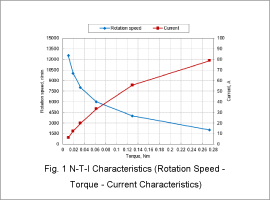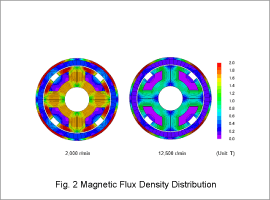*Please prepare a license ID and password for the license administrator.
*It is different from the service for JMAG WEB MEMBER (free membership). Please be careful.
Overview
![[JAC241] Single-Phase Synchronous Motor N-T-I Characteristics Analysis](/images/catalog/e241-0.gif)
The widely used three-phase synchronous motor can be driven efficiently and stably but costs tends to increase due to using an inverter. Whereas since single-phase synchronous motors do not require inverters, they can reduce costs. Furthermore, because they are brushless, maintenance costs can also be lowered.
In a single-phase synchronous motor, the back emf and the current flowing through the coils change in accordance with the rotation speed of the rotor. At low rotation speed, since the back emf is small, a large current flows through the coils, and magnetic saturation occurs in the magnetic circuit.
On the other hand, the back emf increases at high speed, so the current flowing through the coils and torque decrease. Because of this when designing a motor it is important to understand characteristics for a wide range of operating points. Obtaining N-T-I characteristics from performing analysis in JMAG at the design study stage contributes greatly to the speed of motor development.
In this example, a use case in which the N-T-I characteristics for a single-phase synchronous motor are obtained is presented.
In a single-phase synchronous motor, the back emf and the current flowing through the coils change in accordance with the rotation speed of the rotor. At low rotation speed, since the back emf is small, a large current flows through the coils, and magnetic saturation occurs in the magnetic circuit.
On the other hand, the back emf increases at high speed, so the current flowing through the coils and torque decrease. Because of this when designing a motor it is important to understand characteristics for a wide range of operating points. Obtaining N-T-I characteristics from performing analysis in JMAG at the design study stage contributes greatly to the speed of motor development.
In this example, a use case in which the N-T-I characteristics for a single-phase synchronous motor are obtained is presented.
N-T-I Characteristics

Fig. 1 shows an N-T-I characteristics graph.
From Fig. 1, torque for each rotation speed, maximum driving rotation speed, and so on can be seen. The current and torque are roughly proportional.
From Fig. 1, torque for each rotation speed, maximum driving rotation speed, and so on can be seen. The current and torque are roughly proportional.
Magnetic Flux Density Distribution

Fig. 2 shows the magnetic flux density distribution at 2,000 r/min and at 12,500 r/min.
Since a large current flows at a low driving speed, magnetic saturation can be seen in the stator core as well. On the other hand, the current flowing through the coils decreases at high driving speeds, so it can be seen that the magnetic saturation in the stator core is relaxed.
Since a large current flows at a low driving speed, magnetic saturation can be seen in the stator core as well. On the other hand, the current flowing through the coils decreases at high driving speeds, so it can be seen that the magnetic saturation in the stator core is relaxed.


